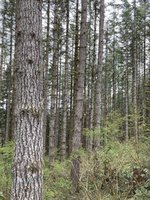Cruiser
Chumono
Adolescent Bark:
Texture smooth-blistered. Gray, green, brown, silver, or whitish in color. Firm to the touch. Thin. Easily damaged. Resin blisters can be popped to release sap.

Developing Bark:
As tree continues to grow and weather, outermost bark cracks, forming linear vertical fissures. Fissures may show younger brown mottled bark within. Exterior bark develops into hard, rough, grayish-brown ridges. Resin blisters have mostly dried out.



At a distance trunk appears vertically wrinkled or striped. Mosses and lichens take hold, especially at old nodes, around branch stubs, and knot indicators.

Mature-Ancient Bark:
Thickly ridged, plated, and/or mottled-flakey.
Mixed in color: various shades of brown and grey, tan, some green hues from adhering plant life, and sometimes patches of black from charring (previous wildfires).


Internal mottled bark layers build up, adding to and enlarging external ridges. Ridges often broaden into chunky plates with deep fissures in between. Plates are corky, hollow-sounding, and lighter in weight than they appear. Occasionally pot-holed. Roughness is sometimes weathered smooth.


Fissures deep enough for a bird to nest in.
Ridges/plates can get sloughed off and may be absent entirely from lower trunk, leaving only mottled-flakey bark.
Mottled-flakey bark is soft, spongy, and loose-shedding. Does not appear as vertically aligned as ridged bark, more broken in appearance. Flakes small, layered, randomly shaped (puzzle-piece), alternating shades of brown, cream, sometimes greenish or sun-bleached grey. Outer flake layers delaminate, like loose pages of an ancient book. May come off in large chunks. Easily crushed in the hand. There is often a pile of bark fragments with other organic debris at tree base.

The sheltered side (right) of this giant has retained its thick ridged bark. The left side is more exposed which has lead to the ridges sloughing off.






Texture smooth-blistered. Gray, green, brown, silver, or whitish in color. Firm to the touch. Thin. Easily damaged. Resin blisters can be popped to release sap.

Developing Bark:
As tree continues to grow and weather, outermost bark cracks, forming linear vertical fissures. Fissures may show younger brown mottled bark within. Exterior bark develops into hard, rough, grayish-brown ridges. Resin blisters have mostly dried out.



At a distance trunk appears vertically wrinkled or striped. Mosses and lichens take hold, especially at old nodes, around branch stubs, and knot indicators.

Mature-Ancient Bark:
Thickly ridged, plated, and/or mottled-flakey.
Mixed in color: various shades of brown and grey, tan, some green hues from adhering plant life, and sometimes patches of black from charring (previous wildfires).


Internal mottled bark layers build up, adding to and enlarging external ridges. Ridges often broaden into chunky plates with deep fissures in between. Plates are corky, hollow-sounding, and lighter in weight than they appear. Occasionally pot-holed. Roughness is sometimes weathered smooth.


Fissures deep enough for a bird to nest in.
Ridges/plates can get sloughed off and may be absent entirely from lower trunk, leaving only mottled-flakey bark.
Mottled-flakey bark is soft, spongy, and loose-shedding. Does not appear as vertically aligned as ridged bark, more broken in appearance. Flakes small, layered, randomly shaped (puzzle-piece), alternating shades of brown, cream, sometimes greenish or sun-bleached grey. Outer flake layers delaminate, like loose pages of an ancient book. May come off in large chunks. Easily crushed in the hand. There is often a pile of bark fragments with other organic debris at tree base.

The sheltered side (right) of this giant has retained its thick ridged bark. The left side is more exposed which has lead to the ridges sloughing off.
























